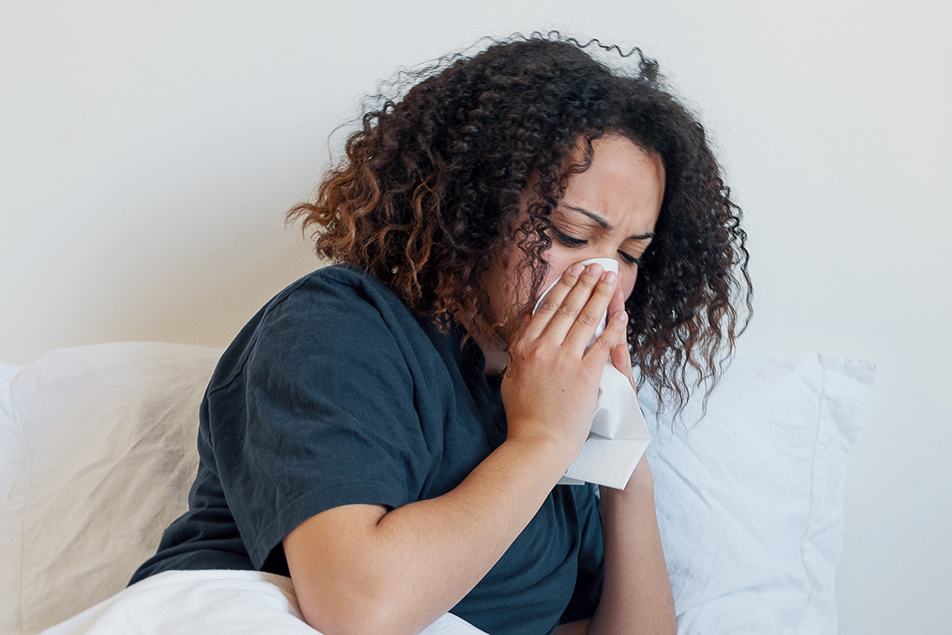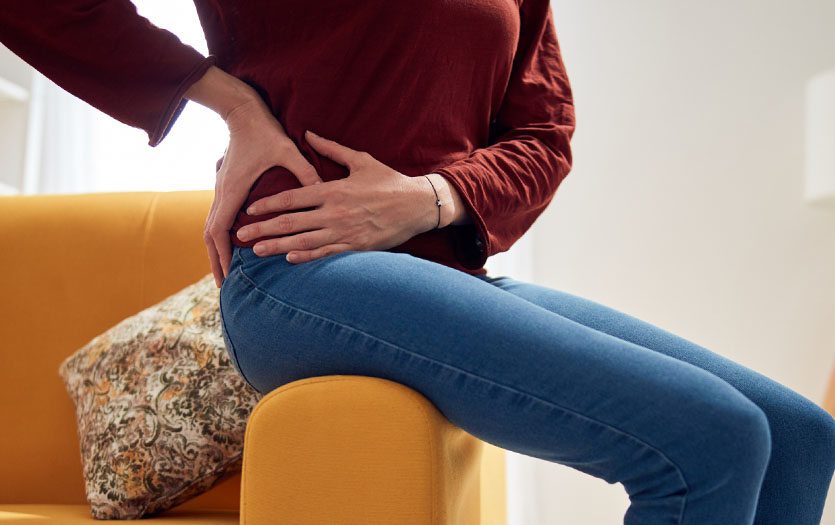
If you or someone you know has symptoms of COVID-19, you may have been asked to stay home and self-quarantine, while managing your own care. Many people may have questions about just what to do when caring for themselves or someone they love with these symptoms. We asked Ryan Singerman, DO, PPG – Family Medicine, to provide us with guidelines on the best way to self-care.
A few notes from Dr. Singerman:
- These are for mild symptoms only. If you are having any difficulty with breathing (chest tightness, breathing rapidly with minimal or no exertion) you should contact your primary care provider or go to the ER.
- Most people with COVID-19 will not need hospitalization and many will do fine with supportive care only. With that said, in this post, I will take each symptom individually and suggest over-the-counter treatments.
- If you have allergies or medical conflicts to any of these suggestions do not use them.
- Generic names will be listed after the brand names. Typically, generic or “store brand” versions of these medications work as well as the brand alternatives.
- These recommendations are for people aged 18 years and older. Because dosages vary significantly, I strongly recommend contacting your primary care provider for guidance in anyone younger than 18.
Symptoms + Treatment
If you or a loved one have …
Fever
Defined as any temperature above 100.4oF, you may use a fever reducer*.
- Ibuprofen up to 800mg every 8 hours, taken with a small snack to avoid stomach upset. (There were concerns initially about using NSAIDS with COVID-19 but these have been proven unfounded, and they are safe for the general public.)
- Naproxen 220mg 1-2 every 12 hours may be substituted for ibuprofen. Do not take both naproxen and ibuprofen.
- Acetaminophen up to 1,000mg every 6 hours (pay attention if getting acetaminophen from other medication/sources like Tylenol PM, Norco, etc., avoid more than 4,000mg total in 24 hours). This may be safely taken with an NSAID like naproxen or ibuprofen.
- If fever persists above 104oF for 4 or more hours, despite using the above recommendations, call your primary care provider.
*Use these dosing guidelines when you take these pain relievers for any of the following symptoms.
Cough
- Any cough drops – I recommend any store brand, sugar-free cough drops.
- Cough syrups (chlorpheniramine, dextromethorphan, and pseudoephedrine):Triaminic Cold and Cough, Robitussin Cough — use brand specific dosing, typically 5-10ml every 4-6 hours.
- Chest Rub camphor / eucalyptus oil / levomenthol / turpentine oil (Vick’s Vapor Rub): Apply to the chest/throat/back as desired.
- Cool mist humidifier in the room most often occupied
Congestion
In the head and/or chest)
- Guaifenesin (Mucinex) 600mg 1-2 tabs every 12 hours
- Take with at least 8 oz of water
- Nasal saline spray hourly as needed
- Any of the above listed cough medicines with pseudoephedrine or phenylephrine
Sore Throat
- Benzocaine liquid/lozenge/spray (Cepacol, Chloraseptic, VapoCool) use brand-specific dosing
- Ibuprofen up to 800mg every 8 hours
- Naproxen 220mg 1-2 every 12 hours may be substituted for ibuprofen. Do not take both naproxen and ibuprofen
- Acetaminophen up to 1,000mg every 6 hours
- 1 tablespoon of honey as needed to soothe scratchy/painful throat
Hoarseness
- Not speaking is the best way to regain the voice
- If you must speak, do not whisper/shout as this will further stress your vocal cords, attempt to speak only in a regular tone
- Warm liquids with honey can help in voice recovery
Body aches
- Ibuprofen up to 800mg every 8 hours
- Naproxen 220mg 1-2 every 12 hours may be substituted for ibuprofen. Do not take both naproxen and ibuprofen
- Acetaminophen up to 1,000mg every 6 hours
General home care guidelines
From the Indiana State Department of Health
1. Stay home except to get medical care. Do not go to work, school, or public areas, and do not use public transportation, ride-sharing, or taxis.
2. Separate yourself from other people and animals in your home. As much as possible, stay in a specific room away from other people in your home. If possible, use a separate bathroom. If you must be in the same room as other people, wear a facemask to prevent spreading germs to others. Although there have not been reports of pets becoming sick with COVID-19, you should also avoid contact with animals or pets while you are sick.
3. Call ahead before visiting your doctor and tell them that you have or may have COVID-19 so they can prepare for your visit and take steps to keep other people from being exposed or infected.
4. Wear a facemask. You should wear a facemask when you are around other people (e.g., sharing a room or vehicle) or pets and before you enter a healthcare provider’s office. If you are not able to wear a facemask (for example, because it causes trouble breathing), then people who live with you should not stay in the same room with you, or they should wear a facemask if they enter your room.
5. Cover coughs and sneezes. To prevent spreading germs to others, when coughing or sneezing cover your mouth and nose with a tissue or your sleeve. Throw used tissues in a lined trash can, and immediately wash hands with soap and water for at least 20 seconds, or use alcohol-based hand sanitizer if soap and water are not available. You should use soap and water if your hands are visibly dirty.
6. Wash your hands often and thoroughly with soap and water for at least 20 seconds. Use alcohol-based hand sanitizer if soap and water are not available and if hands are not visibly dirty. Avoid touching your eyes, nose, and mouth with unwashed hands.
7. Avoid sharing household items. Do not share dishes, drinking glasses, cups, eating utensils, towels, bedding, or other items with other people or pets in your home. These items should be washed thoroughly after use with soap and warm water.
8. Monitor your symptoms. If illness gets worse (e.g., trouble breathing, pain in chest), get medical care right away. Before you visit a clinic or hospital, call your healthcare provider and tell them that you have, or might have, COVID-19. This will help your provider take steps to keep other people from getting infected. If you have a medical emergency and need to call 911, notify the dispatch personnel that you have, or are being evaluated for, COVID-19. If possible, put on a facemask before emergency medical services arrive.
Information for caregivers and household members of COVID-19 patients
From the Indiana State Department of Health
1. Limit visitors to only people caring for the patient. As much as possible, anyone who is not caring for the patient should stay in another home or stay in other rooms. They should also use a separate bedroom and bathroom, if possible. Keep elderly people and those who have weak immune systems or chronic health conditions away from the person.
2. Make sure that shared spaces in the home have good air flow. Open windows or use an air conditioner, if possible.
3. Wash your hands often with soap and water for at least 20 seconds or use an alcohol-based hand sanitizer that contains 60% to 95% alcohol, covering all surfaces of your hands and rubbing them together until they feel dry. You should use soap and water if your hands are visibly dirty.
4. Avoid touching your eyes, nose, and mouth with unwashed hands.
5. Wear a disposable facemask when in the same room as the patient.
6. Wear a disposable facemask and gloves when you touch or have contact with the patient’s blood, body fluids and/or secretions, such as saliva, sputum, nasal mucus, vomit, urine, or diarrhea. Throw these away after use and do not reuse. When removing, first remove and dispose of gloves, then immediately clean your hands with soap and water or alcohol-based hand sanitizer. Next, remove and dispose of the facemask, and immediately clean your hands again with soap and water or alcohol-based hand sanitizer.
7. Avoid sharing household items. Do not share dishes, drinking glasses, cups, eating utensils, towels, bedding, or other items the patient. Follow the cleaning instructions below.
8. Clean all “high-touch” surfaces, such as counters, tabletops, doorknobs, bathroom fixtures, toilets, phones, keyboards, tablets, and bedside tables, every day using household disinfectants. Also, clean any surfaces that may have blood, body fluids and/or secretions or excretions on them.
9. Cleaning Instructions:
• Follow the recommendations provided on cleaning product labels, including precautions you should take when applying the product, such as wearing gloves or aprons and making sure you have good ventilation during use of the product.
• Wash laundry thoroughly. Immediately remove and wash clothes or bedding that have blood, body fluids and/or secretions or excretions on them. Wear disposable gloves while handling soiled items and keep soiled items away from your body. Wash your hands immediately after removing your gloves. Read and follow directions on labels of laundry or clothing items and detergent. In general, wash and dry with the warmest temperatures recommended on the clothing label.
• Place all used disposable gloves, gowns, facemasks, and other contaminated items in a lined container before disposing of them with other household waste. Wash your hands immediately after handling these items.
10. Monitor the patient’s symptoms. If they are getting sicker (e.g., trouble breathing, pain in chest), call their medical provider and tell the medical staff that the person has, or is being evaluated for, COVID-19. This will help the healthcare provider’s office take steps to keep other people from getting infected. Ask the healthcare provider to call the local or state health department for additional guidance. If the patient has a medical emergency and you need to call 911, notify the dispatch personnel that the patient has, or is being evaluated for, COVID-19.
11. Monitor your own health for signs and symptoms of COVID-19, including fever, cough, or shortness of breath. Contact your healthcare provider if you develop any of these symptoms. Call your provider before going to a hospital or clinic to describe your symptoms and let them know that you are a close contact of someone with COVID-19.



